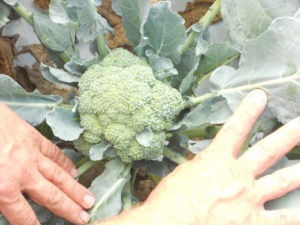Cool nights have finally arrived after the first week of October. Before, we had quite a few days when temperatures were above 90°F. The unusual high temperature has caused problems on early-planted broccoli.
Broccoli is a heat-sensitive crop. The critical period for heat sensitivity is when plants shift growing tips from vegetative growth to flower bud initiation. This is about 10 days before the crown is visible. Temperatures above 90°F during the critical period cause injury on the flower buds. As the crown continues to grow, an uneven head becomes noticeable, and these heads are inclined to be affected by pathogens. Another response broccoli often has toward the heat stress is to grow leaves in the head (Figure 1), although it may be less a concern compared to bud damage.

Figure 1. Broccoli grows leaves in the head. A response toward heat stress (Photo by Luis A. Santiago)
Varieties are varied by heat sensitivity, and they may have slightly different responses toward high-temperature. For example, the very popular variety Emerald Crown tends to make leafy heads while being less susceptible to head unevenness compared to other popular conventional varieties. The organic variety Belstar handles high-temperatures the best among organic varieties.
How long does it take for the crop to reach the critical heat-sensitive window? Studies have found that it could happen within a month in the summer after transplanting. With that said, broccoli crops transplanted in late July or August may suffer heat stress this year.
The market potential is great for broccoli harvested in the early fall. This means crops would develop heads in late summer. The take-home message here is that growers should balance the risk of heat damage and the market potential for early broccoli production. Surely, sometimes, luck plays an important role.
We appreciate Dr. Thomas Björkman at Cornell University for providing valuable information for this article.